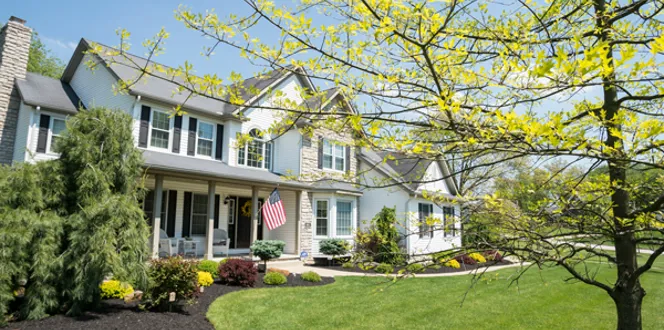When the days get shorter, the skies get gloomier, and you’re coming out of a season full of orange and yellow, the grey and white landscape may become a bleak environment that craves color. When trees traditionally go into the dormant season, they follow the trend with their bare branches.
Luckily, there are several species of trees with colorful barks, blooms, and fruit during the winter months that can help you get that pop of color you crave. In this blog, we provide examples of flowers and plants for winter color.
Add Some Color to your Landscape this Winter
Adding color to your garden enhances the look of your yard, especially during the winter months. Pops of color on white snow and against gray skies is easily noticeable and more interesting. Including striking plants for winter color can also complement the hardscape design you may have established that becomes more visible during the winter.
Best Winter Trees That Add Color From Their Bark
Trees with colorful bark are a great source of color during the winter that adds a different dimension to your garden not usually provided by fruit-bearing or flowering plants. Some examples of the best winter trees with colorful bark are:
- Japanese red maple (zones 5-8): Reddish bark with vibrant leaves that range from deep reds to fiery oranges and stand out amongst most autumn foliage
- Paperbark cherry (zones 5-6): Bark that sheds throughout the year, revealing a coppery, glimmering skin underneath. Provides a shiny accent to your winter landscape
- Coral bark maple (zones 6-8): Branches and twigs are a bright coral red during the winter, which contrasts the tree’s green tones in its trunk. Younger branches are the reddest and will take on a brownish-green tinge with age.
- Redtwig dogwood (zones 2-7): Turn brighter red in cold winters, with younger branches being the reddest. For the full-color effect, cut off 2-year-old stems in the spring and head back 1-year-old ones.
Types of Trees & Shrubs That Bear Fruit in the Cold Months
Some trees bear colorful fruit in the dormant season that provides contrast and color to your landscape. Examples of these winter interest trees and shrubs include:
- Winterberry holly (zones 4-7): Bright red berries can add vibrant color to an all-white landscape
- Holly bush (zones 7-9): Red or gold berries that bring that classic holiday look to your garden
- Cotoneaster (zones 4-7): A fast-growing evergreen plant with bold red berries
- Snowdrift crabapple (zones 4-8): Produces deep orange fruits that attract birds throughout winter
Plants & Flowers That Bloom During Winter
Flowering plants not only provide that necessary color during dormancy but also remind us of the spring ahead with its blooms. Types of winter-blooming trees include:
- Camellias (zones 7-10): Waxy-petal flower that adds shades of pink, reds, or corals through its blooms.
- Star magnolia (zones 4-9): A pest and drought-tolerant plant with white fragrant flowers that bloom in the later months of winter and into spring.
- Snowdrops (zones 3-7): A beautiful white snowdrop flower that blooms when planted during fall.
- Hellebores (zones 4-9): Blooms from late November through winter until spring with a variety of flowers—some being shiny and green, some with light patterning on the leaves, and others with dark leathery flowers.
Plants That Stay Green in Winter (Evergreen Trees)
Evergreen trees are a classic winter staple that, much like the name infers, retain bright green pines and foliage all year long with proper care. Examples of evergreens include:
- Emerald arborvitae (zones 3-7): Shimmering emerald green foliage that naturally grows in a narrow, pyramid shape
- Douglas fir (zones 4-6): Known as the classic Christmas tree, these plants display bluish-green needles and is naturally deer resistant
- Wichita Blue Juniper (zones 3-7): Known for its brilliant, silver-blue foliage, use for large-scale screening or for a serious windbreak. The bright silver-blue foliage retains color year-round.
- Norway Spruce (zones 2-7): Dark green evergreen needles. Withstands heavy snow loads. Tolerates heat and humidity better than others. Ideal windbreak or privacy wall.







